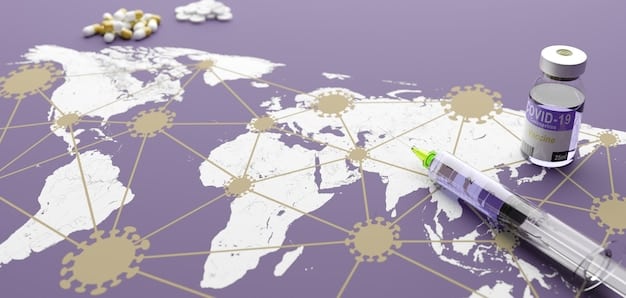International Health Regulations: Implications for US Pandemic Preparedness

The implications of the new International Health Regulations (IHR) for US pandemic preparedness involve navigating a complex landscape of international cooperation, national sovereignty, and public health priorities, requiring proactive engagement to safeguard US interests and global health security.
The implications of the new International Health Regulations for US pandemic preparedness are multifaceted, demanding a thorough understanding of the updated framework and its potential effects on national health security. This article explores these implications, providing insight into how the US can navigate forthcoming global health challenges.
Understanding the International Health Regulations (IHR)
The International Health Regulations (IHR) are a legally binding agreement among 196 countries, including the United States, designed to help the international community prevent and respond to acute public health risks that have the potential to cross borders and spread worldwide. Understanding their core purpose is crucial for appreciating their implications for US pandemic preparedness.
Purpose and Scope of the IHR
The IHR aim to improve the capacity of all countries to detect, assess, report, and respond to public health emergencies of international concern (PHEIC). This includes a wide range of disease outbreaks, chemical spills, and other events that could pose a significant threat to human health globally.
Key Components of the IHR
The regulations outline specific requirements for national surveillance and response systems, as well as guidelines for international cooperation, information sharing, and resource mobilization during health emergencies.
- Early Detection and Reporting: Countries required to promptly report potential PHEICs to the WHO.
- National Capacity Building: Enhancing healthcare infrastructure and workforce readiness.
- International Collaboration: Cooperating with other nations and WHO to manage global health crises.
The International Health Regulations provide a framework that promotes global public health security through coordinated and collaborative management of international health emergencies. Their effectiveness rests on the vigilance and compliance of each participating nation.

The US Role in Shaping and Implementing the IHR
The United States has been a significant player in the development and implementation of the International Health Regulations. Understanding the US role is essential for recognizing the nation’s responsibilities and potential impact on its pandemic preparedness.
US Contributions to the IHR
The US has actively participated in the formulation of IHR guidelines and has provided financial and technical support to help other countries strengthen their health systems and comply with the regulations.
National Implementation of the IHR
Within the US, the Centers for Disease Control and Prevention (CDC) and other federal agencies are responsible for implementing the IHR, ensuring that the country can effectively detect, assess, and respond to public health threats.
- CDC’s Role: Surveillance, lab capacity, and response coordination.
- Inter-agency Cooperation: Collaboration between health, security, and international affairs agencies.
- Funding and Resources: Commitment to global health security initiatives.
The US commitment to the IHR signifies its dedication to global health security, reflected in robust national strategies and international partnerships aimed at pandemic preparedness.
Potential Benefits of the New IHR for US Pandemic Preparedness
The revised International Health Regulations offer several potential benefits for US pandemic preparedness. Comprehending these advantages can pave the way for a more secure and health-conscious nation.
Improved Early Warning Systems
The enhanced requirements for early detection and reporting of potential PHEICs can provide the US with more timely and accurate information about emerging health threats worldwide.
Enhanced International Cooperation
The IHR promote greater collaboration and information sharing among countries, which can help the US gain access to critical data, expertise, and resources during a pandemic.
Strengthened Global Health Security
By improving the capacity of all countries to prevent and respond to health emergencies, the IHR contribute to a more resilient and secure global health environment, reducing the risk of pandemics spreading to the US.
These potential benefits of the new IHR can significantly enhance the US pandemic preparedness by fostering proactive risk assessment and emergency responsiveness.

Challenges and Concerns for the US Regarding the New IHR
Despite the potential benefits, the new International Health Regulations also pose some challenges and concerns for the US. Examining these issues is crucial for addressing and mitigating any negative impacts.
Potential Impacts on National Sovereignty
Some policymakers have raised concerns that the IHR could infringe upon US national sovereignty by requiring the country to share sensitive health information or cede decision-making authority to international bodies.
Resource Constraints and Implementation Costs
Implementing the IHR may require significant investments in public health infrastructure, workforce training, and surveillance systems, which could strain US resources and compete with other national priorities.
Compliance and Enforcement Issues
Ensuring that all countries comply with the IHR can be difficult, and the lack of strong enforcement mechanisms could undermine the effectiveness of the regulations.
Addressing these challenges will be vital for ensuring that the US can fully leverage the benefits of the IHR while safeguarding national interests and priorities.
Adapting US Strategies to Align with the New IHR
To maximize the benefits and mitigate the challenges of the new International Health Regulations, the US needs to adapt its strategies and policies. Aligning national strategies with international guidelines can strengthen global public healthcare.
Strengthening National Surveillance Systems
The US should invest in strengthening its national surveillance systems to improve its ability to detect and track emerging health threats domestically and internationally. This includes enhancing laboratory capacity, improving data collection and analysis, and expanding partnerships with healthcare providers and community organizations.
Enhancing International Collaboration and Information Sharing
The US should actively engage in international collaborations and information-sharing initiatives to gain access to critical data, expertise, and resources during a pandemic. This includes participating in joint research projects, sharing best practices, and providing technical assistance to other countries.
Addressing Legal and Policy Issues
The US should carefully review its laws and policies to ensure that they are aligned with the IHR and do not unduly infringe upon national sovereignty or other constitutional principles. This may require legislative or regulatory changes to clarify the scope of the IHR and protect US interests.
The Future of US Pandemic Preparedness Under the IHR Framework
The implementation of the new International Health Regulations is likely to shape the future of US pandemic preparedness in significant ways. Understanding how the US can evolve and thrive within these regulations is critical.
Continued Investment in Public Health Infrastructure
The US will need to continue investing in its public health infrastructure to maintain its capacity to respond to health emergencies effectively. This includes funding for research and development, workforce training, and emergency preparedness planning.
Strengthening Global Health Partnerships
The US should seek to strengthen its partnerships with other countries and international organizations to promote global health security and prevent future pandemics. This includes providing financial and technical support to help other countries strengthen their health systems and comply with the IHR.
- Multilateral Support: Funding WHO and global health initiatives.
- Bilateral Agreements: Partnering with key countries on pandemic response.
- Capacity Building: Assisting developing nations in enhancing health infrastructure.
The IHR provide a framework for a more integrated and collaborative approach to pandemic preparedness, positioning the US to better safeguard its population and contribute to global health security in the years to come.
| Key Aspect | Brief Description |
|---|---|
| 🚨 Early Detection | Improved systems for identifying and reporting potential health emergencies. |
| 🤝 Collaboration | Enhanced international cooperation for sharing information and resources. |
| 🛡️ Sovereignty | Balancing national interests with international health obligations. |
| 💰 Resource Allocation | Strategic investment in public health infrastructure for effective response. |
Frequently Asked Questions (FAQ)
▼
The IHR are an international legal framework designed to prevent and respond to the spread of infectious diseases and other health threats across borders, ensuring global health security.
▼
The IHR aims to balance the need for international cooperation with the sovereign rights of nations, allowing countries to implement measures that protect their populations while adhering to global health standards.
▼
International collaboration is crucial because infectious diseases can spread rapidly across borders, making coordinated efforts in surveillance, response, and resource sharing necessary to contain outbreaks effectively.
▼
The CDC leads the US implementation efforts, ensuring that the nation’s public health infrastructure is adequate and can respond rapidly to potential international health emergencies under the IHR guidelines.
▼
Adapting US strategies involves strengthening surveillance systems, improving international collaboration, and addressing potential legal and policy issues to ensure compliance and effective implementation of the IHR.
Conclusion
In conclusion, the implications of the new International Health Regulations for US pandemic preparedness are significant, necessitating a proactive and adaptive approach. By addressing challenges, aligning strategies, and fostering international collaboration, the US can enhance its capacity to prevent and respond to future health emergencies, ensuring the safety and well-being of its population and contributing to global health security.





